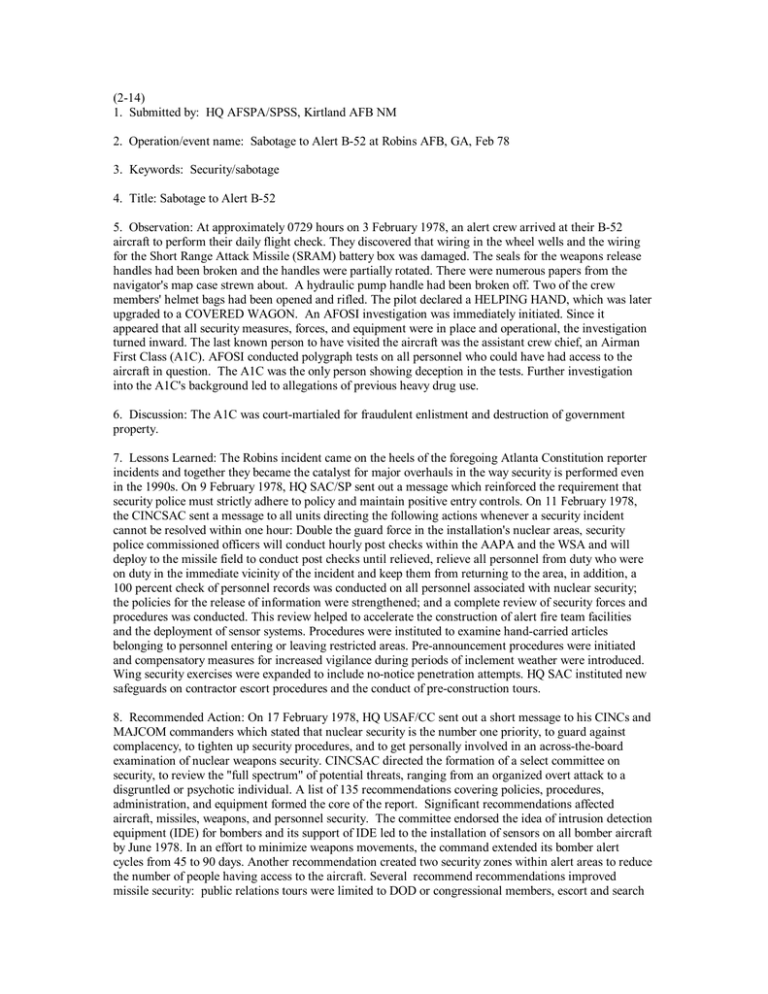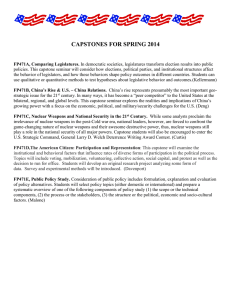(2-14) 1. Submitted by: HQ AFSPA/SPSS, Kirtland AFB NM
advertisement

(2-14) 1. Submitted by: HQ AFSPA/SPSS, Kirtland AFB NM 2. Operation/event name: Sabotage to Alert B-52 at Robins AFB, GA, Feb 78 3. Keywords: Security/sabotage 4. Title: Sabotage to Alert B-52 5. Observation: At approximately 0729 hours on 3 February 1978, an alert crew arrived at their B-52 aircraft to perform their daily flight check. They discovered that wiring in the wheel wells and the wiring for the Short Range Attack Missile (SRAM) battery box was damaged. The seals for the weapons release handles had been broken and the handles were partially rotated. There were numerous papers from the navigator's map case strewn about. A hydraulic pump handle had been broken off. Two of the crew members' helmet bags had been opened and rifled. The pilot declared a HELPING HAND, which was later upgraded to a COVERED WAGON. An AFOSI investigation was immediately initiated. Since it appeared that all security measures, forces, and equipment were in place and operational, the investigation turned inward. The last known person to have visited the aircraft was the assistant crew chief, an Airman First Class (A1C). AFOSI conducted polygraph tests on all personnel who could have had access to the aircraft in question. The A1C was the only person showing deception in the tests. Further investigation into the A1C's background led to allegations of previous heavy drug use. 6. Discussion: The A1C was court-martialed for fraudulent enlistment and destruction of government property. 7. Lessons Learned: The Robins incident came on the heels of the foregoing Atlanta Constitution reporter incidents and together they became the catalyst for major overhauls in the way security is performed even in the 1990s. On 9 February 1978, HQ SAC/SP sent out a message which reinforced the requirement that security police must strictly adhere to policy and maintain positive entry controls. On 11 February 1978, the CINCSAC sent a message to all units directing the following actions whenever a security incident cannot be resolved within one hour: Double the guard force in the installation's nuclear areas, security police commissioned officers will conduct hourly post checks within the AAPA and the WSA and will deploy to the missile field to conduct post checks until relieved, relieve all personnel from duty who were on duty in the immediate vicinity of the incident and keep them from returning to the area, in addition, a 100 percent check of personnel records was conducted on all personnel associated with nuclear security; the policies for the release of information were strengthened; and a complete review of security forces and procedures was conducted. This review helped to accelerate the construction of alert fire team facilities and the deployment of sensor systems. Procedures were instituted to examine hand-carried articles belonging to personnel entering or leaving restricted areas. Pre-announcement procedures were initiated and compensatory measures for increased vigilance during periods of inclement weather were introduced. Wing security exercises were expanded to include no-notice penetration attempts. HQ SAC instituted new safeguards on contractor escort procedures and the conduct of pre-construction tours. 8. Recommended Action: On 17 February 1978, HQ USAF/CC sent out a short message to his CINCs and MAJCOM commanders which stated that nuclear security is the number one priority, to guard against complacency, to tighten up security procedures, and to get personally involved in an across-the-board examination of nuclear weapons security. CINCSAC directed the formation of a select committee on security, to review the "full spectrum" of potential threats, ranging from an organized overt attack to a disgruntled or psychotic individual. A list of 135 recommendations covering policies, procedures, administration, and equipment formed the core of the report. Significant recommendations affected aircraft, missiles, weapons, and personnel security. The committee endorsed the idea of intrusion detection equipment (IDE) for bombers and its support of IDE led to the installation of sensors on all bomber aircraft by June 1978. In an effort to minimize weapons movements, the command extended its bomber alert cycles from 45 to 90 days. Another recommendation created two security zones within alert areas to reduce the number of people having access to the aircraft. Several recommend recommendations improved missile security: public relations tours were limited to DOD or congressional members, escort and search requirements were enhanced, maintenance and inspection procedures were improved to reduce risks to missiles, bullet proof shrouds were required during reentry vehicle (RV) transport to protect assets under convoy, duress and deadman switches were provided to missile combat crews and security police sentries, and outer zone security alarm systems were improved and the procurement of armored response vehicles was expedited. The security of weapons in storage was a third topic of concern. The committee recommended modernization of WSA sensor systems and security force communications systems. The number of convoy movements was reduced and any weapon transported would be covered to reduce public emotional reaction and random K-9 patrols were reinstated. Munitions maintenance personnel were issued firearms during convoys. Safe corridors using static posts and road blocks were established during all RV shipments. Personnel issues were thoroughly reviewed, with emphasis on security police morale and motivation. Security education and motivation programs were personalized. The number of supervisory personnel was increased and human reliability programs were strengthened. The use of deadly force policy was enhanced and clarified. Firing ranges were modernized and weapons training was enhanced. The law dealing with illegal entry into a restricted area was changed to a felony crime. Missile security forces were aligned under the wing commander. 9. OPR Comments: This report, like the 1969 and the 1972 reports before it, tightened access to nuclear weapons, endorsed the use of sensors as a method of reducing the risk of sabotage or attack, and reaffirmed traditional security techniques. The committee's most significant effort was its review of the human element. Their recommendations figured prominently in the improved nature of police duty; better working conditions; a more professional approach to security; and better overall asset protection.





